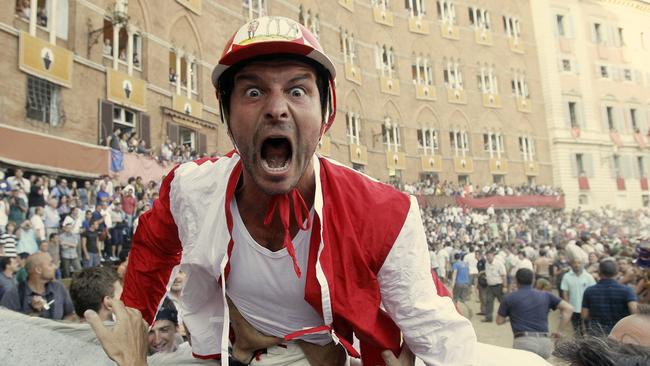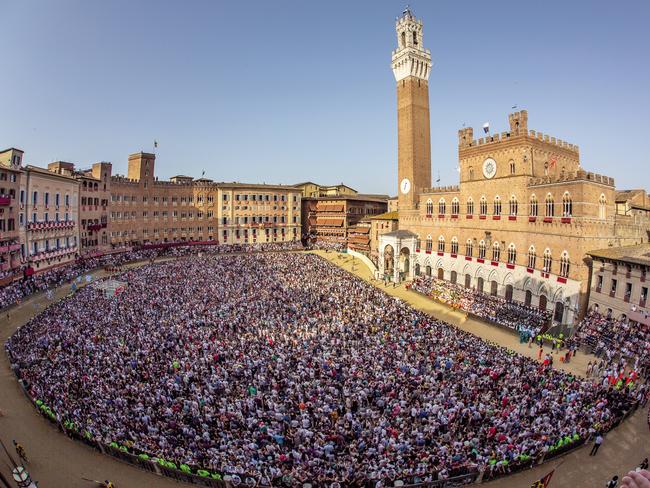Only Palio di Siena is as brutal as this
Where in the world can you find mafiosos, mothers, and medicos shoulder to shoulder, roaring at animals in a town square, hoping to win a banner that bears the face of the Madonna?

Where in the world can you find mafiosos, mothers and medicos shoulder to shoulder, roaring at animals in a town square, hoping to win a banner that bears the face of the Madonna? Palio di Siena.
This famous bareback horse race is held twice a year, on July 2 and August 16, in the mountain-top Tuscan town of Siena. Seventeen jockeys and their horses each represent a contrada, like a small suburb. They race on clay around the at-times fatally tight corners of the Piazza del Campo and jockeys are permitted to whip their own horses as well as the steeds of their competitors.
Oh yes, and the jockeys bribe one another under the sun in front of thousands of people – but you aren’t allowed to place any bets. Go figure.
I know, it’s a lot, but it’s really not just anarchy for the thrill of cruel abandon. Hundreds of years of rivalry and camaraderie culminate on the clay.

This is no Fantasia parade. Gloriously, Palio will go ahead with just as much gusto whether there are no tourists or tens of thousands. The Sienese don’t care if you’re there and I guarantee this alone will be the highlight of your holiday.
So many cities manufacture shows for tourism that are totally devoid of charisma (looking at you, Sydney’s Vivid). But not Siena. Everything that happens on the clay circuit in Siena is solemnly significant.
The crowd is boisterous but not fuelled by beer. There are no big screens or stadium speakers on the medieval buildings, and there is a total absence of gaudy commercial sponsor logos or announcements about where to get help if you are trampled. No one is hushing the crowds so the horses won’t spook as they marshal.

As a tourist you can pay several hundred euros for the privilege of sitting above the crowds, possibly in the shade, on grandstands no sturdier than a foal’s knees. You’d severely cut your risk of heat stroke up there, I’m sure.
But if the hustle and bustle call your name, join me and tens of thousands of others in the square. Around 50 people start to claim territory in the campo, which is free to enter, right near the starting rope from about 10.30am. If you joined them, you would be missing out on the festivity of the day. It’s not worth your time. Instead, arrive in Siena by midday and choose a contrada to support.
Each has a mascot, like a giraffe, dragon or panther. Buy a flag for €10 ($16.80) from a tobacco shop, tie it at the front of your neck and throw the silky triangle behind you, then get going to your local contrada.
Position yourself close to your contrada’s church doors at about 2pm, then you’ll be in a prime position to enter the church to watch the blessing of the horse. Most tourists will miss this opportunity but you should forgo an afternoon Aperol if it means you’ll make this unique spectacle. If you didn’t know what was happening it would look like this was the part they left out of Noah’s ark, where the horses stand in front of a priest with heads bowed, praying for a spot on the boat.

From about 3pm you’ll just follow the sound of drums, which you can’t miss. Before the race starts, I watch paramedics reluctantly drop their cigarettes on the track to carry out four people by stretcher from the crowds. Heat exhaustion, probably. A white-gloved police officer holding an envelope to the sky is the only prompt the crowd needs to go quiet. He makes his way through the throngs to the mayor, who reads out the order in which the horses will line up.
“Tartuca.” A few cheers for the tortoise contrada. Then the caterpillar, the snail, the goose and then the panther.
“Aquila.” A 40,000-strong “ooooh” rumbles through the square at the announcement of the eagle contrada’s starting position.
Panther and eagle have been sworn enemies since the 1930s, so thousands of necks crane for a view as the two jockeys agitate each other and their noble horses at the rope. Yes, at the rope. There are no barriers here. The horses buck at one another and startle their neighbours like dominos. Reportedly, the last time the eagle beat the panther, a speaker mounted on a church blared out a chant to mock the panther 24 hours a day for six weeks.
The horse race may look totally lawless, but it does crack the whip on the tradition of how the race starts. That’s why we’re up to our fifth false start on the August 16 Palio. It’s my first time, so I ask the woman next to me why they keep restarting.
She says the horses must all line up against the rope in the order shouted out by the mayor, and they have to stand totally still. They are not doing this, of course, with the hind legs of their enemy bucking them in 35C heat.
“The rules are clear but impossible to follow,” she adds. Apparently the nonsense of Italian bureaucracy knows no limits.
My newly beloved giraffe contrada is first past the rope and puts a good 40m on the second horse before hurling into the wall on a sharp turn, throwing the jockey off into the middle of the track. Horses gallop over and around the jockey as he crawls along, trying to avoid a 500kg hoof.
Then three more jockeys become airborne and one particular horse, having just shed its 60kg rider, takes and maintains the lead for two whole laps. In the final 20m, it cuts off a horse and jockey threatening to take the inside lead, sending man and animal flying.
The crowds jump the barricades and run on to the track to follow the triumphant jockey-free horse across the finish line. In Palio, it’s not the jockey who wins, it’s the horse.
Following animal rights protests in recent years, it has been reported that all former Palio horses retire to rolling green pastures in the Caggio equestrian centre in Radicondoli, Tuscany.
Although that does sound a lot like when your dog dies and your parents tell you it went to live on a farm. And the race feels, and maybe should be, illegal.
It’s the sort of thing you can’t imagine has actually bypassed picket lines and red tape to go ahead in the 21st century. The Sienese say it will live forever.
But I would urge you to go before it’s too late.
In the know
Palio di Siena is held every year on July 2 and August 16. There are trial races and communal dinners in the days leading up to the race so getting there a couple of days early is a great idea.
aboutsiena.com





To join the conversation, please log in. Don't have an account? Register
Join the conversation, you are commenting as Logout